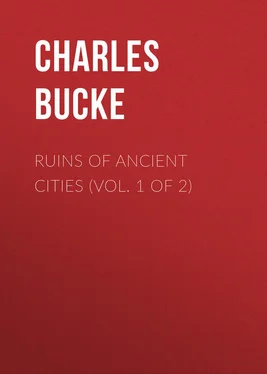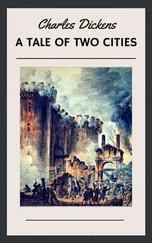Charles Bucke - Ruins of Ancient Cities (Vol. 1 of 2)
Здесь есть возможность читать онлайн «Charles Bucke - Ruins of Ancient Cities (Vol. 1 of 2)» — ознакомительный отрывок электронной книги совершенно бесплатно, а после прочтения отрывка купить полную версию. В некоторых случаях можно слушать аудио, скачать через торрент в формате fb2 и присутствует краткое содержание. Жанр: foreign_antique, foreign_prose, на английском языке. Описание произведения, (предисловие) а так же отзывы посетителей доступны на портале библиотеки ЛибКат.
- Название:Ruins of Ancient Cities (Vol. 1 of 2)
- Автор:
- Жанр:
- Год:неизвестен
- ISBN:нет данных
- Рейтинг книги:4 / 5. Голосов: 1
-
Избранное:Добавить в избранное
- Отзывы:
-
Ваша оценка:
- 80
- 1
- 2
- 3
- 4
- 5
Ruins of Ancient Cities (Vol. 1 of 2): краткое содержание, описание и аннотация
Предлагаем к чтению аннотацию, описание, краткое содержание или предисловие (зависит от того, что написал сам автор книги «Ruins of Ancient Cities (Vol. 1 of 2)»). Если вы не нашли необходимую информацию о книге — напишите в комментариях, мы постараемся отыскать её.
Ruins of Ancient Cities (Vol. 1 of 2) — читать онлайн ознакомительный отрывок
Ниже представлен текст книги, разбитый по страницам. Система сохранения места последней прочитанной страницы, позволяет с удобством читать онлайн бесплатно книгу «Ruins of Ancient Cities (Vol. 1 of 2)», без необходимости каждый раз заново искать на чём Вы остановились. Поставьте закладку, и сможете в любой момент перейти на страницу, на которой закончили чтение.
Интервал:
Закладка:
The temples, also, were very magnificent. That of Æsculapius, two columns and two pilasters of which now support the end of a farm-house, was not less celebrated for a statue of Apollo. It was taken from them by the Carthaginians, at the same time that the Temple of Juno was burnt. It was carried off by the conquerors, and continued the greatest ornament of Carthage for many years; but was, at last, restored by Scipio, at the final destruction of the city. Some of the Sicilians allege, but it is supposed without ground, that this statue was afterward carried to Rome, and still remains there, the wonder of all ages; and known to the whole world, under the name of the Apollo Belvidere.
An edifice of the Doric order, called the Temple of Concord, has still its walls, its columns, entablature, and pediments, entire. In proceeding from the Temple of Concord, you walk between rows of sepulchres, cut in the rock, wherever it admitted of being excavated by the hand of man, or was so already by that of nature. Some masses are hewn into the shape of coffins; others drilled full of small square holes, employed in a different mode of interment, and serving as receptacles of urns. One ponderous piece of the rock lies in an extraordinary position. By the failure of its foundation, or the shock of an earthquake, it has been loosened from the general quarry, and rolled down the declivity, where it now remains supine, with the cavities turned upwards. There was also a temple dedicated to Ceres and Proserpine; with the ruins was formed a church, which now exists; and the road, leading to which, was cut out of the solid rock. In respect to the temple of Castor and Pollux, vegetation has covered the lower parts of the building, and only a few fragments of two columns appear between the vines. Of the Temple of Venus, about one half remains; but the glory of the place was the Temple of Jupiter Olympius, three hundred and forty feet long, sixty broad, and one hundred and twenty in height. Its columns and porticos were in the finest style of architecture; and its bas-reliefs and paintings executed with admirable taste. On its eastern walls was sculptured the Battle of the Giants; while the western represented the Trojan War; corresponding exactly with the description which Virgil had given of the painting in the Temple of Juno at Carthage.
Diodorus Siculus extols the beauty of the columns which supported the building; the admirable structure of the porticos, and the exquisite taste with which the bas-reliefs and paintings were executed; but he adds, that the stately edifice was never finished. Cicero, against Verres, speaks of the statues he carried away. Mr. Swinburne says, that it has remaining not one stone upon another; and that it is barely possible, with the liberal aid of conjecture, to discover the traces of its plan and dimensions. He adds, however, that St. Peter's at Rome exceeds this celebrated temple more than doubly in every dimension; being two hundred and fifteen feet higher, three hundred and thirty-four longer, and four hundred and thirty-three wider.
Added to these, there is now remaining a monument of Tero, king of Agrigentum, one of the first of the Sicilian tyrants. The great antiquity of this monument may be gathered from this; that Tero is not only mentioned by Diodorus, Polybius, and the more modern of the ancient historians, but likewise by Herodotus, and Pindar, who dedicates two of his Olympic Odes to him; so that this monument must be much more than two thousand years old. It is a kind of pyramid, the most durable of forms; and is surrounded by aged olive-trees, which cast a wild, irregular shade over the ruin.
All these mighty ruins of Agrigentum, and the whole mountain on which it stands, says Mr. Brydone, is composed of an immense concretion of seashells, run together, and cemented by a kind of sand, or gravel, and now become as hard, and perhaps more durable, than even marble itself. This stone is white before it has been exposed to the air; but in the temples and other ruins it is become "set," of a very dark brown. These shells are found on the very summit of the mountain, which is at least fourteen or fifteen hundred feet above the level of the sea.
The celebrated Empedocles was a native of this city; one of the finest spirits that ever adorned the earth. His saying, in regard to his fellow-citizens, is well known; – viz., that they squandered their money so excessively every day, that they seemed to expect it could never be exhausted; and that they built with such solidity and magnificence, as if they thought they should live for ever 8 8 Livy, Cicero, Diodorus Siculus, Rollin, Brydone; Encyl. Lond., Brewster's Encyl.
.
NO. VI. – ALBA LONGA
It has been stated, or rather speculated upon, that the entire history of this place is no other than a romance. By Dionysius of Halicarnassus, however, it is said to have existed four hundred and eighty-seven years; when, after having been the founder of thirty other Latin cities, it was destroyed by the Roman power.
That it existed, is also attested by the ruins that now remain. Its ancient characteristics are thus described by Dionysius: – it was so built, with regard to its mountain and lake, that it occupied a space between them, each serving like a wall of defence to the city.
It was long supposed to have been situated where Palazzuolo now is. Sir W. Gell says, "On passing up the new road, running from the dry bed of the river Albanus, where it crosses the Appian Way, near Bolerillæ, and leading to the Villa Torlonia, or Castel Gandolfo, a few ancient tombs were observed about half way up the ascent; and further examination showed, that these tombs had once bordered an ancient road, now almost obliterated. It was obvious, that such a road must have led from some place on the plain, to another on the mountain. Toward the sea, the high tower of Pratica (Lavinium) lay in the direct line of the road; and it seemed certain that the city on the mountain, to which it led, could have been no other than Alba Longa. Climbing upward among the bushes, ponderous blocks of stone were discovered, evidently the remains of the walls of this city. By a farther search, more were found. At a distance a small cavern was discovered; and not only the remains of a well, but part of a column of stone, two feet four inches in diameter. At a higher point the shore was covered with ruins, consisting of large blocks of rectangular stones, nearly buried in the soil, and scarcely discernible among the bushes."
There is a tradition, that the palaces of the kings of Alba stood on a rock; and so near to the edge of the precipice, that when the impiety of one of its monarchs provoked Jupiter to strike it with his lightning, a part of the mass was precipitated into the lake, carrying the impious king along with the ruins of his habitation. This tradition is apparently confirmed by a singular feature in a part of the remains of this city; for, directly under the rock of the citadel, toward the lake, and where the palace, both for security and prospect, would have been placed, is a cavern, fifty feet in depth, and more than one hundred in width; a part of the roof of which has evidently fallen in, and some of the blocks still remain on the spot 9 9 Dionysius of Halicarnassus; – Sir W. Gell.
.
NO. VII. – ALCANTARA
This town (in Spain) was built by the Moors, who gave it the name it bears; which, in the Moorish language, signifies a bridge; and this bridge shows that the original city belonged to the Romans in the time of Trajan; for on one of the arches is this inscription: —
Formerly there were four pieces of marble, fixed in the walls of the bridge; in each of which there was an inscription, containing the names of the several towns and districts, that contributed towards the expense of making it. Three of these marbles are lost; but the fourth remains, and bears the following inscription: —
Читать дальшеИнтервал:
Закладка:
Похожие книги на «Ruins of Ancient Cities (Vol. 1 of 2)»
Представляем Вашему вниманию похожие книги на «Ruins of Ancient Cities (Vol. 1 of 2)» списком для выбора. Мы отобрали схожую по названию и смыслу литературу в надежде предоставить читателям больше вариантов отыскать новые, интересные, ещё непрочитанные произведения.
Обсуждение, отзывы о книге «Ruins of Ancient Cities (Vol. 1 of 2)» и просто собственные мнения читателей. Оставьте ваши комментарии, напишите, что Вы думаете о произведении, его смысле или главных героях. Укажите что конкретно понравилось, а что нет, и почему Вы так считаете.












